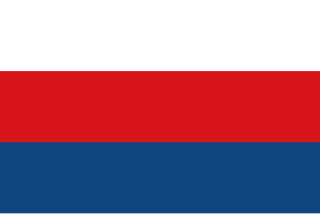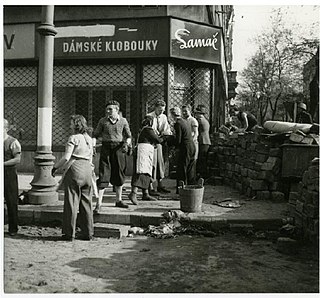Chad Bryant is an American historian of central and eastern Europe, especially the Czech lands. He is a Professor of History at the University of North Carolina at Chapel Hill. [1] [2]
Chad Bryant is an American historian of central and eastern Europe, especially the Czech lands. He is a Professor of History at the University of North Carolina at Chapel Hill. [1] [2]

The Czech Republic, also known as Czechia, is a landlocked country in Central Europe. Historically known as Bohemia, it is bordered by Austria to the south, Germany to the west, Poland to the northeast, and Slovakia to the southeast. The Czech Republic has a hilly landscape that covers an area of 78,871 square kilometers (30,452 sq mi) with a mostly temperate continental and oceanic climate. The capital and largest city is Prague; other major cities and urban areas include Brno, Ostrava, Plzeň and Liberec.

Czechoslovakia was a landlocked state in Central Europe, created in 1918, when it declared its independence from Austria-Hungary. In 1938, after the Munich Agreement, the Sudetenland became part of Nazi Germany, while the country lost further territories to Hungary and Poland. Between 1939 and 1945, the state ceased to exist, as Slovakia proclaimed its independence and the remaining territories in the east became part of Hungary, while in the remainder of the Czech Lands, the German Protectorate of Bohemia and Moravia was proclaimed. In 1939, after the outbreak of World War II, former Czechoslovak President Edvard Beneš formed a government-in-exile and sought recognition from the Allies.

Prague is the capital and largest city in the Czech Republic, and the historical capital of Bohemia. On the Vltava river, Prague is home to about 1.3 million people. The city has a temperate oceanic climate, with relatively warm summers and chilly winters.

Reinhard Tristan Eugen Heydrich was a high-ranking German SS and police official during the Nazi era and a principal architect of the Holocaust.

Charles University, also known as Charles University in Prague or historically as the University of Prague, is the oldest and largest university in the Czech Republic. It is one of the oldest universities in Europe in continuous operation. Today, the university consists of 17 faculties located in Prague, Hradec Králové, and Plzeň. Charles University belongs among the top three universities in Central and Eastern Europe. It is ranked around 300 in the world.
The Czechs, or the Czech people, are a West Slavic ethnic group and a nation native to the Czech Republic in Central Europe, who share a common ancestry, culture, history, and the Czech language.
The First Czechoslovak Republic emerged from the collapse of the Austro-Hungarian Empire in October 1918. The new state consisted mostly of territories inhabited by Czechs and Slovaks, but also included areas containing majority populations of other nationalities, particularly Germans (22.95 %), who accounted for more citizens than the state's second state nation of the Slovaks, Hungarians (5.47 %) and Ruthenians (3.39 %). The new state comprised the total of Bohemia whose borders did not coincide with the language border between German and Czech. Despite initially developing effective representative institutions alongside a successful economy, the deteriorating international economic situation in the 1930s gave rise to growing ethnic tensions. The dispute between the Czech and German populations, fanned by the rise of Nazism in neighbouring Germany, resulted in the loss of territory under the terms of the Munich Agreement and subsequent events in the autumn of 1938, bringing about the end of the First Republic.

The Protectorate of Bohemia and Moravia was a partially-annexed territory of Nazi Germany that was established on 16 March 1939 after the German occupation of the Czech lands. The protectorate's population was mostly ethnic Czech.

A Reichsgau was an administrative subdivision created in a number of areas annexed by Nazi Germany between 1938 and 1945.

Jan Kubiš was a Czech soldier, one of a team of Czechoslovak British-trained paratroopers sent to eliminate acting Reichsprotektor (Realm-Protector) of Bohemia and Moravia, SS-Obergruppenführer Reinhard Heydrich, in 1942 as part of Operation Anthropoid. During the attack, Kubiš threw the bomb that mortally wounded Heydrich.

Karl Hermann Frank was a prominent Sudeten German Nazi official in the Protectorate of Bohemia and Moravia prior to and during World War II. Attaining the rank of Obergruppenführer, he was in command of the Nazi police apparatus in the protectorate, including the Gestapo, the SD, and the Kripo. After the war, Frank was tried, convicted and executed by hanging for his role in organizing the massacres of the people of the Czech villages of Lidice and Ležáky.

The Prague uprising was a partially successful attempt by the Czech resistance movement to liberate the city of Prague from German occupation in May 1945, during the end of World War II. The preceding six years of occupation had fuelled anti-German sentiment and the rapid advance of Allied forces from the Red Army and the United States Army offered the resistance a chance of success.

German Bohemians, later known as Sudeten Germans, were ethnic Germans living in the Czech lands of the Bohemian Crown, which later became an integral part of Czechoslovakia. Before 1945, over three million German Bohemians constituted about 23% of the population of the whole country and about 29.5% of the population of Bohemia and Moravia. Ethnic Germans migrated into the Kingdom of Bohemia, an electoral territory of the Holy Roman Empire, from the 11th century, mostly in the border regions of what was later called the "Sudetenland", which was named after the Sudeten Mountains.

The Second Hungarian Republic was a parliamentary republic briefly established after the disestablishment of the Kingdom of Hungary on 1 February 1946 and was itself dissolved on 20 August 1949. It was succeeded by the Hungarian People's Republic.

The Slav Epic is a cycle of 20 large canvases painted by Czech Art Nouveau painter Alphonse Mucha between 1910 and 1928. The cycle depicts the mythology and history of Czechs and other Slavic peoples. In 1928, after finishing his monumental work, Mucha bestowed the cycle upon the city of Prague on the condition that the city build a special pavilion for it.
Vojtech Mastny is an American historian of Czech descent, professor of political science and international relations, specializing in the history of the Cold War. He has been considered one of the leading American authorities on Soviet affairs. Mastny received his Ph.D. from Columbia University and has been professor of history and international relations at Columbia, University of Illinois, Boston University and the Johns Hopkins School of Advanced International Studies, as well as professor of strategy at U.S. Naval War College, Fulbright professor at the University of Bonn, senior research scholar at the Woodrow Wilson International Center for Scholars and senior fellow at the National Security Archive. He is the coordinator of the Parallel History Project. In 1996-1998 he was the first researcher awarded Manfred Wörner Fellowship by NATO. Mastny's books include Continental Europe under Nazi Rule, which won him the Clarke F. Ansley award in 1971, Russia's Road to the Cold War (1979), The Helsinki Process and the Reintegration of Europe (1992) and The Cold War and Soviet Insecurity: The Stalin Years, which won the American Historical Association's 1997 George L. Beer Prize.

The Final Solution of the Czech Question was the Nazi German plan for the complete Germanization of the Protectorate of Bohemia and Moravia. German sociologist and anthropologist Karl Valentin Müller asserted that a large part of the Czech nation was racially Aryan and could be Germanized. This was in stark contrast to Germany's Final Solution to the Jewish Question. However, Müller asserted that the Germanization should take place without coercion; instead, he suggested a system of social incentives.
Prague in Black: Nazi Rule and Czech Nationalism (2007) is a book by the American historian Chad Bryant about how Czech nationalism developed in the German-occupied Protectorate of Bohemia and Moravia during World War II. It received mostly favorable reviews.
National indifference is the status of lacking a strong and consistent national identity. The concept was originated by scholars of the Bohemian lands, where many inhabitants historically resisted classification as either Czechs or Germans, around 2000. It was outlined by Tara Zahra in her 2010 paper published in Slavic Review, "Imagined Noncommunities: National Indifference as a Category of Analysis". In 2016, an academic conference was held in Prague to discuss the concept.

Marianne "Mausi" Grant was a Czech-Scottish Jewish artist,who survived the Holocaust after being imprisoned in three successive concentration camps. Grant was born during the interwar period and came from a prosperous family. From a young age, Grant loved drawing and painting but her plans to study art at university were stymied after the invasion of Czechoslovakia in March 1939 by Nazi Germany. In June 1939, the Nurember racial laws were implemented and Grant and her family faced increasingly stringent restrictions that lead them to be interred at a camp in Prague and then later deported to the Theresienstadt Ghetto in May 1942. Grant spent 18 months in the ghetto before being transferred to Auschwitz concentration camp. In Auschwitz, Grant used her painting skills in exchange for food and medicine and to make the children's block where she worked, more homely. However, her work come to the notice of Josef Mengele, who used Grant to paint family trees of dwarfs and twins. After 7 months, Grant was sent to forced labour battalion and later Bergen-Belsen concentration camp. When she was liberated, she was sent to Sweden to recuperate and met her future husband. They married and settled in Glasgow. After the war, she finished her education at the Glasgow School of Art. In 2002, Grant's paintings and drawings were exhibited at Kelvingrove Art Gallery and Museum. 22 members of Grant's family died in the Holocaust.